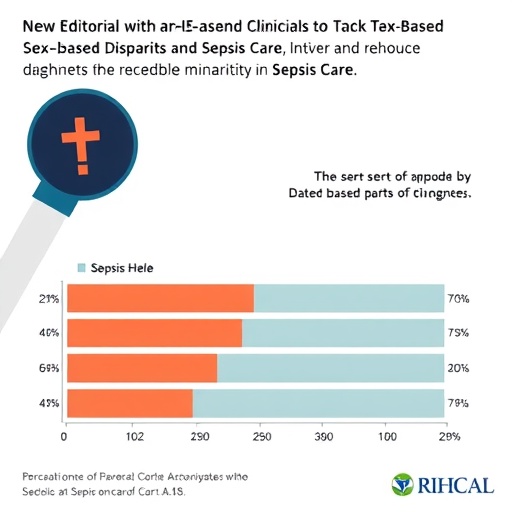Sepsis remains a formidable challenge in intensive care units worldwide, representing a major cause of mortality despite significant advancements in detection and treatment protocols. Central to combating sepsis is antibiotic therapy, which serves as the foundational pillar of patient management. Yet, a critical flaw has persisted largely underrecognized: the lack of individualized antibiotic dosing that accounts for patient-specific variables, most notably those rooted in biological sex and gender-related factors. Recent discourse in the Journal of Intensive Medicine has illuminated these gaps, drawing urgent attention to the consequences of gender-blind antimicrobial regimens and calling for a paradigm shift towards precision dosing.
The editorial, authored by notable experts Dr. Helena Barrasa, Dr. Goiatz Balziskueta, and Professor Jordi Rello, underscores the profound impact that sex-related physiological differences and gender disparities exert on antibiotic pharmacokinetics and pharmacodynamics. While traditionally, antibiotic dosing regimens have relied on standardized, “one-size-fits-all” approaches, emerging evidence reveals that men and women process and respond to these agents in fundamentally different ways. These differences not only influence drug efficacy but also govern susceptibility to adverse reactions and treatment failures, particularly in the high-stakes context of sepsis therapy.
In women, hormonal modulation of hepatic enzymes, variations in body fat percentage, and renal clearance dynamics markedly alter drug absorption, distribution, metabolism, and excretion. These biological factors result in altered antibiotic plasma levels, often leading to elevated drug concentrations if standard male-centric dosing models are applied. Consequently, women face increased risks of antibiotic overexposure, which can manifest as toxicity or heightened adverse effects. Despite this, clinical trials have consistently underrepresented women, and many dosing guidelines fail to integrate sex-specific pharmacological data, perpetuating a cycle of suboptimal care.
Conversely, biological men—especially younger individuals—commonly exhibit augmented renal clearance, a phenomenon where increased glomerular filtration rates accelerate drug elimination. This condition predisposes these patients to subtherapeutic antibiotic concentrations, risking inadequate bacterial eradication and fostering treatment failure. Such disparities highlight the hazardous assumption underpinning universal dosing strategies and illuminate the necessity of individualized regimens that accommodate renal function kinetics alongside sex and hormonal influences.
Beyond biology, gender—defined as the societal roles, behaviors, and expectations assigned to individuals—introduces additional complexity to sepsis management. Women frequently encounter healthcare inequities including delayed recognition of symptoms, reduced urgency in treatment initiation, and implicit biases within emergency and critical care settings. These factors compound biological vulnerabilities, translating to tangible disparities in clinical outcomes. Gender norms and healthcare-seeking behaviors further exacerbate these inequities, underscoring a multidimensional problem wherein biology and sociocultural factors intertwine to undermine optimal dosing and care delivery.
Such intricate interplays between sex- and gender-related variables necessitate a reexamination of current antimicrobial dosing algorithms. The editorial stresses that overlooking these critical elements not only jeopardizes patient safety but also impedes stewardship efforts to combat rising antibiotic resistance. Overexposure in women can contribute to toxicities and selective pressures fostering resistant pathogens. Simultaneously, underdosing in men risks persistent infections and amplification of resistant strains through treatment failure and prolonged microbial load.
The proposed solution lies in the wider implementation of therapeutic drug monitoring (TDM), a precision medicine tool enabling real-time adjustment of antibiotic dosing based on measured plasma drug levels and individual patient characteristics. TDM has demonstrated efficacy in reducing toxicity, optimizing therapeutic windows, and curtailing resistance emergence. Incorporating sex- and gender-informed considerations within TDM protocols could revolutionize sepsis management, shifting the paradigm from standardized to personalized antimicrobial strategies, thereby bridging a critical equity gap.
Moreover, the authors highlight a striking deficiency in current research frameworks: fewer than 30% of published studies report sex-stratified data, and even fewer integrate gender analyses. This dearth of sex- and gender-disaggregated data stifles progress toward evidence-based dosing guidelines that are inclusive and reflective of the diverse patient population. Enhancing clinical research designs to routinely include these parameters is imperative to generate robust pharmacological insights and foster equitable care.
Professor Jordi Rello, a senior consultant and prominent voice in intensive care and infectious diseases, encapsulates this urgency by affirming, “Understanding the differences shaped by sex and gender is essential to advancing personalized medicine and represents a commitment to reducing the equity gap.” This commitment demands concerted efforts spanning clinical practice, research, and health policy, catalyzing a comprehensive shift in how sepsis is treated worldwide.
The editorial from Vall d’Hebron University Hospital’s expert team thus signals a pivotal inflection point in critical care pharmacology. It calls for an integrated, multidisciplinary approach that respects biological complexity and socio-cultural dynamics alike. Ultimately, embracing sex- and gender-aware antimicrobial dosing stands to not only improve survival rates among septic patients but also enhance the overall quality of intensive care medicine, paving the way for truly personalized, equitable treatment modalities in one of healthcare’s most challenging arenas.
In summary, sepsis therapy requires urgent refinement to incorporate sex-specific biological factors and gender-influenced healthcare disparities. This transformation mandates better representation of women in clinical trials, use of therapeutic drug monitoring tailored by sex and gender, and dismantling of systemic biases affecting treatment delivery. Such evolution in practice and research will be fundamental for optimizing antimicrobial efficacy, minimizing harm, and addressing the pervasive equity gaps that jeopardize patient outcomes in sepsis management.
Subject of Research: People
Article Title: Sex-related differences in antimicrobial dosing for sepsis: Bridging the equity gap
News Publication Date: 8-Sep-2025
Web References:
Journal of Intensive Medicine DOI link
References:
DOI: 10.1016/j.jointm.2025.08.004
Image Credits:
theglobalpanorama from Openverse
Keywords:
Infectious diseases, Sepsis, Pharmacology, Antibiotic resistance, Personalized medicine, Gender studies, Clinical research, Health disparity
Tags: addressing gender disparities in healthcare.adverse reactions in sepsis treatmentgender-blind antimicrobial regimensgender-related factors in antibiotic pharmacokineticshormonal influences on drug metabolismimpact of sex on drug efficacyindividualized antibiotic dosing in sepsispersonalized medicine in intensive carephysiological differences in sepsis therapyprecision dosing for sepsis treatmentSex-based disparities in sepsis caretailored antibiotic therapy for women





